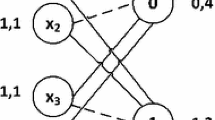Abstract
We derive by means of disjunctive programming the convex hull representation of logical conditions called cardinality rules given by Hong and Hooker (1999), and specify an efficient separation algorithm for the family of inequalities defining the convex hull. We then extend both the convex hull characterization and the efficient separation procedure to more general logical conditions.
Similar content being viewed by others
References
E. Balas, “Disjunctive programming: Properties of the convex hull of feasible points,” Invited paper with a foreword by G. Cornuéjols and W.R. Pulleyblank, Discrete Applied Mathematics, vol. 89, pp. 1–44, 1998.
E. Balas, A. Bockmayr, N. Pisaruk, and L. Wolsey, “On unions and dominants of polytopes,” Mathematical Programming, vol. 99, pp. 223–239, 2004.
Hong Yan and J.N. Hooker, “Tight representation of logical constraints as cardinality rules,” Mathematical Programming, vol. 85, pp. 363–377, 1999.
Author information
Authors and Affiliations
Rights and permissions
About this article
Cite this article
Balas, E. Logical Constraints as Cardinality Rules: Tight Representation. Journal of Combinatorial Optimization 8, 115–128 (2004). https://doi.org/10.1023/B:JOCO.0000031413.33955.62
Issue Date:
DOI: https://doi.org/10.1023/B:JOCO.0000031413.33955.62




